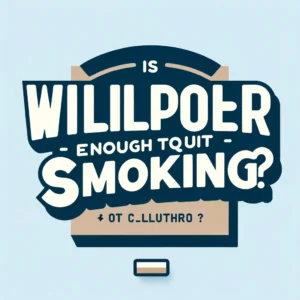

When it comes to quitting smoking, you’ll often hear about “withdrawals” and “cravings” as if they’re the same thing. They’re not, and knowing the difference can make your journey to becoming smoke-free a bit smoother. Let’s break it down simply.
What Does Quitting Feel Like?
Imagine you’ve just put out a cigarette. That nagging feeling that pops up, nudging you to light up another? That’s nicotine withdrawal. It’s your body missing its regular hit of nicotine, which is the addictive substance in cigarettes. Nicotine withdrawal isn’t painful—it’s more like a persistent whisper saying, “Hey, remember me?” This happens because every cigarette you smoke trains your body to expect its next nicotine fix, creating a cycle of need.
On the other side are cravings. Cravings are more about the mind than the body. They’re fueled by the belief that smoking gives you something valuable, like a way to relax or a break from boredom. It’s the feeling that something is missing when you can’t light up, especially in moments when you’re used to having a cigarette in hand.
Understanding Withdrawals and Cravings
So, withdrawals are your body asking for nicotine, while cravings are your brain missing the perceived benefits of smoking. Imagine two monsters: one in your body (the physical addiction) and one in your head (the psychological addiction). When you stop smoking, the little monster (your body) sends a signal that it misses nicotine. How you respond to that signal—if you see smoking as beneficial—wakes up the big monster (your craving).
But what if you didn’t see smoking as beneficial? What if, instead, you recognized that the relaxation and stress relief it seemed to provide were just illusions?
The Path to Being Smoke-Free
Realizing that cravings stem from our beliefs about smoking can change everything. If you strip away the so-called benefits of smoking, you quiet the big monster. Yes, you might still experience withdrawals, but these physical sensations are mild and pass within a few days. The key is understanding that a craving isn’t an unignorable command; it’s just a thought, one that loses its power when you change how you view smoking.
This shift in perspective is at the heart of the QSFS method I’ve developed. It’s about seeing through the smoke, so to speak, and understanding what’s really happening inside you when you think you need a cigarette. With this clarity, you can navigate the quitting process not just with hope but with confidence.
Becoming a non-smoker isn’t about battling a constant state of wanting; it’s about learning, understanding, and finally, celebrating the freedom of not needing to smoke at all.
Still struggling to quit?
Our free eBook reveals the surprising mental root cause of smoking addiction—and how to overcome it.
Share via:



